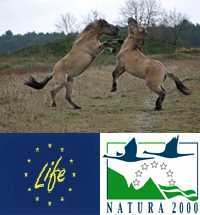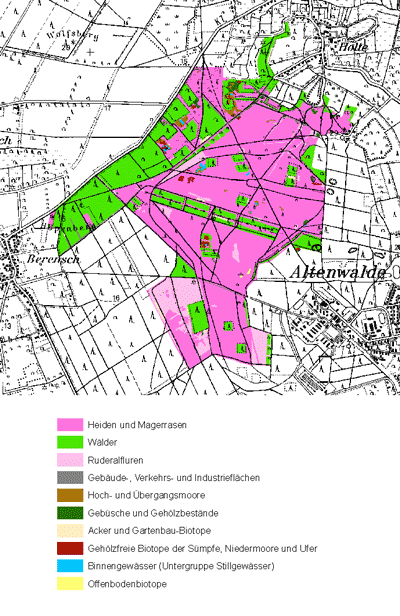 Bildrechte: NLWKN
Bildrechte: NLWKNBiotope and Habitat Types in the Project Area
Within the framework of the LIFE project, the biotope and habitat types of the project area were mapped in the summer of 2006.
A total of 47 habitat types were identified. The table below shows the main 10 groups.
|
Main Group |
Hectares |
% Area |
|---|---|---|
|
Heaths and lean turf |
347,24 |
59,85 |
|
Forests |
157,52 |
27,15 |
|
Ruderal fields |
46,02 |
7,93 |
|
Buildings, roads and industrial estates |
11,01 |
1,90 |
|
Raised bogs and transition mires |
5,64 |
0,98 |
|
Shrubs and trees |
5,31 |
0,92 |
|
Fields and horticultural biotopes |
3,17 |
0,55 |
|
Wood-free habitats of marshes, fens, river banks and lake shores |
2,57 |
0,44 |
|
Inland water (subgroup standing body of water) |
1,29 |
0,22 |
|
Habitats of open ground |
0,40 |
0,07 |
9 habitat types were identified in the LIFE project area:
| 3130 | Oligotrophic to mesotrophic standing waters with vegetation of the Littorelletea uniflorea and/or of the Isoëto-Nanojuncetea |
| 3160 | Natural dystrophic lakes and ponds |
| 4010 | Northern Atlantic wet heaths with Erica tetralix |
| 4030 | European dry heaths |
| 5130 | Juniperus communis formations on heaths or calcareous grasslands |
| 7140 | Transition mires and quaking bogs |
| 7150 | Depressions on peat substrates of the Rhynchosporion |
| 9190 | Old acidophilous oak woods with Quercus robur on sandy plains |
| 91D0* | Bog woodland |
Approximately 68% of the LIFE project area consists of habitat types under the Habitats Directive, a total of 395.84 hectares. Compared to the national level, this is above average. The area balance for the three classes of conservation,
A – very good conservation status
B – good conservation status
C – medium to poor conservation status
makes it obvious that on the whole the conservation status of the majority of habitat types under the Habitats Directive is currently medium to poor. Maintenance and development measures are necessary to restore a good conservation status.
|
FFH- |
Size of areas according to conservation status |
Total (%) |
|||||
|
A ha |
A % |
B ha |
B % |
C ha |
C % |
||
|
3130 |
0,00 |
0,0 |
0,45 |
0,08 |
0,11 |
0,02 |
0,10 |
|
3160 |
0,10 |
0,02 |
0,64 |
0,1 |
0,00 |
0,0 |
0,11 |
|
4010 |
0,00 |
0,0 |
4,32 |
0,8 |
2,33 |
0,4 |
1,15 |
|
4030 |
74,07 |
12,8 |
97,24 |
16,8 |
187,67 |
32,3 |
61,84 |
|
5130 |
0,00 |
0,0 |
0,01 |
0,001 |
0.00 |
0,0 |
0,001 |
|
7140 |
0,15 |
0,03 |
1,76 |
0,3 |
0,36 |
0,1 |
0,39 |
|
7150 |
0,00 |
0,0 |
0,33 |
0,1 |
0,01 |
0,002 |
0,06 |
|
9190 |
4,57 |
0,8 |
1,86 |
0,3 |
19,78 |
3,4 |
4,50 |
|
91D0* |
0,00 |
0,0 |
0,00 |
0,0 |
0,18 |
0,03 |
0,03 |
|
Total |
78,88 |
13,6 |
106,62 |
18,4 |
210,34 |
36,2 |
68,14 |
 Bildrechte: NLWKN
Bildrechte: NLWKN- LIFE Nature Project
- Project Sponsors and Financing
- Project Goals
- Project Organisation
- Location and Size
- Usage History
- Geology and Soils
- Biotope and Habitat Types
- Animal and Plant Species
- Project of National Significance
- Natura 2000, Nature Reserve
- Heck Cattle and Konik Horse Grazing
- Wisent Grazing
- Small Ponds
- Development of Forests Suited to the Location
- Removal of Small Trees and Shrubs
- Information for Visitors
Artikel-Informationen
Ansprechpartner/in:
Hannah Burmester
Nds. Landesbetrieb für Wasserwirtschaft, Küsten- und Naturschutz
Betriebsstelle Lüneburg
Adolph-Kolping-Str. 6
D-21337 Lüneburg
Tel: +49 (0)4131 2209-221



